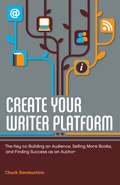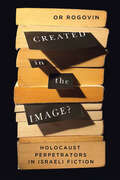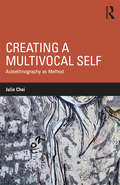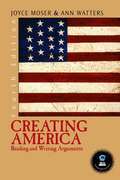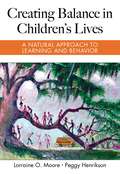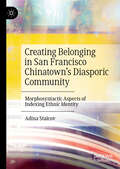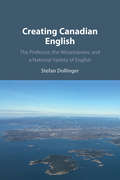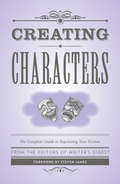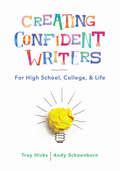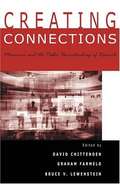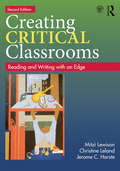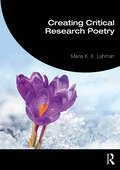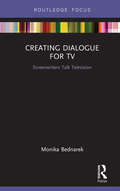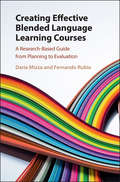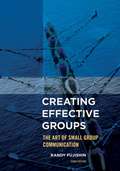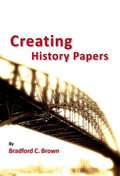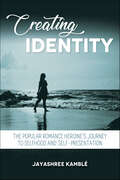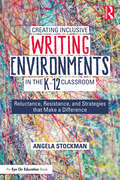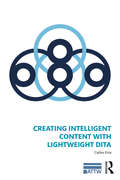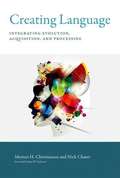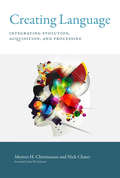- Table View
- List View
Create Your Writer Platform: The Key to Building an Audience, Selling More Books, and Finding Success as an A uthor
by Chuck SambuchinoCreating a platform isn't just beneficial--it's essential! In today's world of blogging, websites, Twitter feeds, and Facebook updates, building a writer platform from the ground up can seem a daunting task. Never fear--author and editor Chuck Sambuchino provides expert, practical advice for increasing your visibility, selling more books, and launching a successful career. In Create Your Writer Platform, you'll learn: The definition of a platform--and why you should start building one now. How to harness the 12 Fundamental Principles of Platform. "Old School" and "New School" approaches to platform, from article writing and conference speaking to website development, blog posts, and social media avenues. How to develop a platform for nonfiction, fiction, and memoir. In addition to Chuck's invaluable insights, you'll also find 12 case studies from authors with effective platforms, as well as professional advice from literary agents. If you're serious about building a platform tailored to you and your writing--a platform that's going to help you succeed as a writer--look no further than Create Your Writer Platform.
Created in the Image?: Holocaust Perpetrators in Israeli Fiction (McGill-Queen’s Azrieli Institute of Israel Studies Series #3)
by Or RogovinThe turn of the twenty-first century saw the rise of a brand of fiction that centres the experience and perspective of the perpetrator, thereby humanizing this character and granting it the capability to evoke our empathy. The vast scholarship published on this phenomenon, however, fails to consider Israeli writing, and with it some of the most complex characterizations of Holocaust perpetrators, imagined from the unparalleled position of a nation that was shaped from its very birth by the legacy of Holocaust victimhood and survival.In Created in the Image? Or Rogovin situates Israeli literary responses to the Holocaust in the canon of perpetrator fiction for the first time. Since the state’s establishment in 1948, perpetrator characterization in Israeli fiction has demonstrated a remarkable development that corresponds to changing circumstances, from the Eichmann trial to the First Intifada. While early examples depicted perpetrators stereotypically and minimally - as seen in Ka-Tzetnik’s demonic and bestial Nazis in Salamandra and in the amorphous persecutor figures in Aharon Appelfeld’s stories - since the mid-1980s these characters have been created in the human image, as nuanced and multidimensional individuals. The turning point came with Herr Neigel, the sensitive and self-contradictory commandant in David Grossman’s See Under: Love (1986), followed by likewise multifaceted and humanized perpetrators in fiction by A.B. Yehoshua, Savyon Liebrecht, and Amir Gutfreund.Anchored in theoretical and comparative perspectives, Created in the Image? presents a groundbreaking analysis of the poetic mechanisms, moral implications, and historical contexts of this paradigm shift in the Israeli literary response to the Shoah.
Creating a Freelance Career
by Jill L. FergusonCreating a Freelance Career covers everything anyone needs to know about becoming a freelance writer, graphic designer, copy editor, artist, musician or any other creative occupation. It includes chapters on how to get started with your career and where to look for work, how to write pitch or query letters, how to work with contract employers, and how to build and sustain your business. Lingo necessary for successfully navigating the freelance world is defined throughout. Author Jill L. Ferguson, an experienced freelance professional and educator, guides you through finding success in the gig economy, discussing how to pursue freelancing with an entrepreneurial spirit. Creating a Freelance Career includes examples of what to do, and what not to do, when pursuing freelance projects, and includes perspectives from additional real-life professionals who have found success in their fields.
Creating a Multivocal Self: Autoethnography as Method
by Julie ChoiShowcasing a new methodology in language learning and identity research, this carefully conceptualized, innovative book explicates the use of autoethnography as a way of re-imagining one’s sense of linguistic and cultural identity. A key work for researchers and students in Applied Linguistics and Language Education, it addresses fundamental aspects of research methodology and explores substantive issues relating to individual dimensions of multilingualism. Choi shows convincingly how the learning of a language is inseparable from one’s constant searching for a voice, a place, and a self in this world, demonstrating the importance of interrogating what lies behind everyday life events and interactions—the political and ethical implications of the utterances, thoughts, actions, and stories of the self and others. Themes of authenticity, illegitimacy, power relations, perceptions of self/other, cultural discourses and practices, and related issues in multilingual identity development surface in the multi-modal narratives. Chapters on methodology, woven through the book, focus on the process of knowledge production, approaches to writing narratives, the messiness of research writing practices, and the inseparability of writing and research.
Creating America: Reading and Writing Arguments (Fourth Edition)
by Joyce Moser Ann WattersThematic argument reader with rhetoric (writing guide) on arguments presents selections and images that depict the political and social changes in America from the Revolutionary War to the twenty-first century. Its argumentative focus will teach readers how to persuade others through written words and visual ideas. High Interest topics including 27 new essays, 4 films, and 10 advertisements/pieces of art; information on visual arguments and online research; an in-depth examination of one country's culture within a range of cultures over time. For persuasive writers.
Creating Balance in Children: A Guide for Teachers and Parents of Children Ages 5 to 14
by Lorraine O. MooreEducate the whole child with over one hundred activities that promote physical, cognitive, and emotional/social balance in children!This insightful resource helps educators, parents, and childcare providers discover how emotions affect learning and behavior, recognize the symptoms and sources of imbalance, and promote students' physical, mental, emotional, and social development. Students and teachers will learn more about the body-mind-heart connection, the importance of nutrition, and options for correcting and preventing imbalance with over one-hundred activities.Using the author's flexible guidelines, teachers can help children develop attributes such as kindness and courage, love and joy, and a sense of meaning and interconnectedness. Creating Balance in Children: Activities to Optimize Learning and Behavior takes the lessons learned from Creating Balance in Children’s Lives and transforms them into easy-to-use activities for use in the home and the classroom.
Creating Balance in Children's Lives: A Natural Approach to Learning and Behavior
by Lorraine MooreThrough the 1990s and into the present, concerns have increased regarding children's learning, behavior and health. In this book, educators, parents, and childcare providers will find options for addressing these concerns. The strategies presented will help balance and optimize children's physical, mental, emotional, and social development. Look inside to learn more about; the many aspects of balance; how the body, mind, and heart work together; how emotions affect learning and behavior; the importance of nutrition; meeting children's basic needs; how to recognize symptoms and sources of imbalance; options for preventing and correcting imbalances. Children are the world's most precious resources. A cooperative effort on the part of adults in behalf of all children is urgently needed to set the course for our future. This book can be a guide for this important process.
Creating Belonging in San Francisco Chinatown’s Diasporic Community: Morphosyntactic Aspects of Indexing Ethnic Identity
by Adina StaicovThis book presents a much-needed discussion on ethnic identification and morphosyntactic variation in San Francisco Chinatown—a community that has received very little attention in linguistic research. An investigation of original, interactive speech data sheds light on how first- and second-generation Chinese Americans signal (ethnic) identity through morphosyntactic variation in English and on how they co-construct identity discursively. After an introduction to the community’s history, the book provides background information on ethnic varieties in North America. This discussion grounds the present book within existing research and illustrates how studies on ethnic varieties of English have evolved. The book then proceeds with a description of quantitative and qualitative results on linguistic variation and ethnic identity. These analyses show how linguistic variation is only one way of signalling belonging to a community and highlight that Chinese Americans draw on a variety of sources, most notably the heritage language, to construct and negotiate (ethnic) identity. This book will be of particular interest to linguists - particularly academics working in sociolinguistics, language and identity, and language variation - but also to scholars interested in related issues such as migration, discrimination, and ethnicity.
Creating Canadian English: The Professor, the Mountaineer, and a National Variety of English
by Stefan DollingerThis lively account of the making of Canadian English traces the variety's conceptual, social and linguistic developments from the twentieth century to the present. This book is not just another history of Canadian English; it is a history of the variety's discovery, codification, and eventual acceptance, as well as the contribution of the linguists behind it. Written by an active research linguist focusing on Canadian English, this book is an archive-based biography on multiple levels. Through a combination of new data and re-interpretations of existing studies, a new voice is given to earlier generations of Canadian linguists who, generally forgotten today, shaped the variety and how we think about it. Exploring topics such as linguistic description and codification, dictionary making, linguistic imperialism, linguistic attitudes, language and Canadian identity, or the threat of Americanisation, Dollinger presents a coherent, integrated and balanced account of developments spanning over almost a century.
Creating Characters: The Complete Guide to Populating Your Fiction (Creative Writing Essentials)
by Steven James Writer's Digest EditorsCreate characters that leap off the page--and into readers' hearts! Populating your fiction with authentic, vivid characters is a surefire way to captivate your readers from the first sentence to the last. Whether you're writing a series, novel, short story, or flash fiction, Creating Characters is an invaluable guide to bringing your fictional cast to life. This book is a comprehensive reference to every stage of character development. You'll find timely advice and helpful instruction from best-selling authors like Nancy Kress, Elizabeth Sims, Orson Scott Card, Chuck Wendig, Hallie Ephron, Donald Maass, and James Scott Bell. They'll show you how to: Effectively introduce your characters Build a believable protagonist Develop strong anti-heroes and compelling villains Juggle multiple points of view without missing a beat Craft authentic dialogue that propels the story forward Motivate your characters with powerful objectives and a believable conflict Show dynamic character development over the course of a story No matter what your genre, Creating Characters gives you the tools necessary to create realistic, fascinating characters that your readers will root for and remember long after they've finished the story.
Creating Comics as Journalism, Memoir and Nonfiction
by Randy Duncan Michael Ray Taylor David StoddardThis book provides student journalists, artists, designers, creative writers and web producers with the tools and techniques they need to tell nonfiction stories visually and graphically. Weaving together history, theory, and practical advice, seasoned nonfiction comics professors and scholars Randy Duncan, Michael Ray Taylor and David Stoddard present a hands-on approach to teach readers from a range of backgrounds how to develop and create a graphic nonfiction story from start to finish. The book offers guidance on: -how to find stories and make use of appropriate facts and visuals; -nonfiction narrative techniques; -artist's tools and techniques; -print, digital, and multimedia production; -legal and ethical considerations. Interviews with well-known nonfiction comics creators and editors discuss best practices and offer readers inspiration to begin creating their own work, and exercises at the end of each chapter encourage students to hone their skills.
Creating Confident Writers: For High School, College, And Life
by Troy Hicks Andy SchoenbornWriting should be for an audience other than a teacher, and for a purpose beyond getting a grade. Connecting their classroom experience to research about writing, as well as to framing documents in the field, two seasoned writing teachers distill the lessons they’ve learned about creating confident adolescent and young adult writers. Troy Hicks and Andy Schoenborn outline a fundamental stance to their approach—to invite, encourage, and celebrate students’ writing—that is then echoed in the book’s three-part structure. There are numerous classroom activities and assignments on topics from creating writing goals to supporting revision, examples of student work, and questions to guide teachers’ reflections. In this book for any teacher of writing, from middle school through college, readers are invited to try strategies and allow students’ voices to emerge, while discussing with colleagues how these approaches might work for them, too.
Creating Connections: Museums and the Public Understanding of Current Research
by Bruce Lewenstein David Chittenden Graham FarmeloThis fundamentally human need to find out about the world led to the creation of this book.
Creating Critical Classrooms: Reading and Writing with an Edge
by Mitzi Lewison Christine Leland Jerome C. HarsteThis popular text articulates a powerful theory of critical literacy—in all its complexity. Critical literacy practices encourage students to use language to question the everyday world, interrogate the relationship between language and power, analyze popular culture and media, understand how power relationships are socially constructed, and consider actions that can be taken to promote social justice. By providing both a model for critical literacy instruction and many examples of how critical practices can be enacted in daily school life in elementary and middle school classrooms, Creating Critical Classrooms meets a huge need for a practical, theoretically based text on this topic. Pedagogical features in each chapter • Teacher-researcher Vignette • Theories that Inform Practice • Critical Literacy Chart • Thought Piece • Invitations for Disruption • Lingering Questions New in the Second Edition • End-of-chapter "Voices from the Field" • More upper elementary-grade examples • New text sets drawn from "Classroom Resources" • Streamlined, restructured, revised, and updated throughout • Expanded Companion Website now includes annotated Classroom Resources; Text Sets; Resources by Chapter; Invitations for Students; Literacy Strategies; Additional Resources
Creating Critical Research Poetry
by Maria K. LahmanCreating Critical Research Poetry critically engages with the ways in which researchers can poetically approach textual representations that narrate the unnarratable and contest the uncontested.This text provides a rich path for early research poets to engage with and bloom and established research poets to dig deeper and flourish.Connections to literary poetry and critical social science theories are detailed. First-person poetic accounts where poets describe early fruitful engagement with poetic forms are highlighted. Free verse, formed poetry, and dimensional poems (e.g. concrete poetry) are covered in depth, with guidance for developing a poetic sensibility and honing research poetry craft. Poetic experiences are integrated throughout the book, which may be engaged with individually, as a group, and in virtual or face-to-face courses.Each chapter provides reflexive questions for the reader to engage with in their own journal writings, a poem creation exercise, and further poetic resources. Set within critical theories, Creating Critical Research Poetry provides a context for early research poets, and thought-provoking possibilities for seasoned research poets. This is the perfect entry point to this burgeoning field of critical inquiry and qualitative research.
Creating Dialogue for TV: Screenwriters Talk Television (Routledge Studies in Media Theory and Practice)
by Monika BednarekAs entertaining as it is enlightening, Creating Dialogue for TV: Screenwriters Talk Television presents interviews with five Hollywood professionals who talk about all things related to dialogue – from naturalistic style to the building of characters to swearing and dialect. Screenwriters/showrunners David Mandel (Curb Your Enthusiasm, Veep), Jane Espenson (Buffy, Battlestar Galactica, Once Upon a Time), Robert Berens (Supernatural), Sheila Lawrence (Gilmore Girls, Ugly Betty, The Marvelous Mrs Maisel), and Doris Egan (Tru Calling, House, Reign) field a linguist’s inquiries about the craft of writing dialogue. This book is for anyone who has ever wondered what creative processes and attitudes lie behind the words they encounter when tuning into their favourite television show. It provides direct insights into Hollywood writers’ knowledge and opinions of how language is used in television narratives, and in doing so shows how language awareness, attitudes and the craft of using words are utilised to create popular TV series. The book will appeal to students and teachers in screenwriting, creative writing and linguistics as well as lay readers.
Creating Effective Blended Language Learning Courses: A Research-Based Guide from Planning to Evaluation
by Daria Mizza Fernando RubioBlended language courses, which combine face-to-face and online instruction, are becoming increasingly popular due to the need for more flexible yet effective learning opportunities. This book recognizes the associated opportunities and challenges for teachers, and provides the rationale, strategies and tools to design blended learning courses or to guide the transition from fully face-to-face or fully online courses to blended instruction. The authors propose a framework based on four phases, Design, Build, Teach and Evaluate, which facilitates a systematic approach to course development. The volume simplifies the connection between theory and practice, by including examples that readers can relate to and immediately implement as they build or teach a course. Including case studies of successful implementations, and effective instructional strategies and techniques, this book is accessible even for teachers without previous experience in course design, whilst also acting as a reference for more experienced language educators.
Creating Effective Groups: The Art of Small Group Communication (Third Edition)
by Randy FujishinThis practical book gives students the fundamental knowledge and skills necessary to communicate more effectively and interact more productively in the small group setting. With the help of this book, any group member can learn the skills necessary to participate in and lead a task group in an effective, productive, and healthy manner. This third edition features all new sections on: . "The Power of Diversity" . "Critically Thinking About Yourself As A Communicator" . "Defensive vs. Supportive Climates" . "Ethical Communication" . "Time Management" . "Impromptu Speaking" . "The Spirit of Collaboration" As well as new end chapter exercises in several chapters focusing on Online Resources and Social Media. "
Creating History Papers (Students And Professional Concerns)
by Bradford BrownThis reference guide is a must-read for all history students that addresses the howsof history papers, and presents technical information to aid in the process of researching, writing, and documenting.
Creating Identity: The Popular Romance Heroine's Journey to Selfhood and Self-Presentation
by Jayashree KambléWhile the world often categorizes women in reductive false binaries—careerist versus mother, feminine versus fierce—romance novels, a unique form of the love story, offer an imaginative space of mingled alternatives for a heroine on her journey to selfhood.In Creating Identity, Jayashree Kamblé examines the romance genre, with its sensile flexibility in retaining what audiences find desirable and discarding what is not, by asking an important question: "Who is the romance heroine, and what does she want?" To find the answer, Kamblé explores how heroines in ten novels reject societal labels and instead remake themselves on their own terms with their own agency. Using a truly intersectional approach, Kamblé combines gender and sexuality, Marxism, critical race theory, and literary criticism to survey various aspects of heroines' identities, such as sexuality, gender, work, citizenship, and race. Ideal for readers interested in gender studies and literary criticism, Creating Identity highlights a genre in which heroines do not accept that independence and strong, loving relationships are mutually exclusive but instead demand both, echoing the call from the very readers who have made this genre so popular.
Creating Inclusive Writing Environments in the K-12 Classroom: Reluctance, Resistance, and Strategies that Make a Difference
by Angela StockmanTimely and accessible, this book offers tangible strategies that will help teachers plan and sustain writing workshop experiences that are responsive to the needs of their specific students. Angela Stockman helps teachers understand why some writers may fail to meet their expectations and how to help all writers reach their fullest potential. Organized in three parts, this book reframes common narratives about resistant writers, empowers teachers to design, lead and refine their workshop, and provides a toolkit to do so. The appendices and eResources included provide teachers with instructions for mini-lessons and learning targets that support multimodal composition, perfect for pre-service and in-service teachers.
Creating Intelligent Content with Lightweight DITA (ATTW Series in Technical and Professional Communication)
by Carlos EviaCreating Intelligent Content with Lightweight DITA documents the evolution of the Darwin Information Typing Architecture (DITA) – a widely used open standard for structuring technical content. DITA has grown in popularity and features since its origins as an internal grammar for structuring technical documentation at IBM. This book introduces Lightweight DITA (LwDITA, which should be read as "Lightweight DITA") as a proposed version of the DITA standard that reduces its dependence on complex Extensible Markup Language (XML) structures and simplifies its authoring experience. This volume aims to reconcile discrepancies and similarities in methods for authoring content in industry and academia and does so by reporting on DITA’s evolution through the lens of computational thinking, which has been connected in scholarship and media to initiatives for learning to code and programming. Evia’s core argument is that if technical communicators are trained with principles of rhetorical problem solving and computational thinking, they can create structured content in lightweight workflows with XML, HTML5, and Markdown designed to reduce the learning curve associated with DITA and similar authoring methodologies. At the same time, this book has the goal of making concepts of structured authoring and intelligent content easier to learn and teach in humanities-based writing and communication programs. This book is intended for practitioners and students interested in structured authoring or the DITA standard.
Creating Language: Integrating Evolution, Acquisition, and Processing
by Nick Chater Peter W. Culicover Morten H. ChristiansenLanguage is a hallmark of the human species; the flexibility and unbounded expressivity of our linguistic abilities is unique in the biological world. In this book, Morten Christiansen and Nick Chater argue that to understand this astonishing phenomenon, we must consider how language is created: moment by moment, in the generation and understanding of individual utterances; year by year, as new language learners acquire language skills; and generation by generation, as languages change, split, and fuse through the processes of cultural evolution. Christiansen and Chater propose a revolutionary new framework for understanding the evolution, acquisition, and processing of language, offering an integrated theory of how language creation is intertwined across these multiple timescales.Christiansen and Chater argue that mainstream generative approaches to language do not provide compelling accounts of language evolution, acquisition, and processing. Their own account draws on important developments from across the language sciences, including statistical natural language processing, learnability theory, computational modeling, and psycholinguistic experiments with children and adults. Christiansen and Chater also consider some of the major implications of their theoretical approach for our understanding of how language works, offering alternative accounts of specific aspects of language, including the structure of the vocabulary, the importance of experience in language processing, and the nature of recursive linguistic structure.
Creating Language: Integrating Evolution, Acquisition, and Processing
by Morten H. Christiansen Nick ChaterA work that reveals the profound links between the evolution, acquisition, and processing of language, and proposes a new integrative framework for the language sciences.Language is a hallmark of the human species; the flexibility and unbounded expressivity of our linguistic abilities is unique in the biological world. In this book, Morten Christiansen and Nick Chater argue that to understand this astonishing phenomenon, we must consider how language is created: moment by moment, in the generation and understanding of individual utterances; year by year, as new language learners acquire language skills; and generation by generation, as languages change, split, and fuse through the processes of cultural evolution. Christiansen and Chater propose a revolutionary new framework for understanding the evolution, acquisition, and processing of language, offering an integrated theory of how language creation is intertwined across these multiple timescales.Christiansen and Chater argue that mainstream generative approaches to language do not provide compelling accounts of language evolution, acquisition, and processing. Their own account draws on important developments from across the language sciences, including statistical natural language processing, learnability theory, computational modeling, and psycholinguistic experiments with children and adults. Christiansen and Chater also consider some of the major implications of their theoretical approach for our understanding of how language works, offering alternative accounts of specific aspects of language, including the structure of the vocabulary, the importance of experience in language processing, and the nature of recursive linguistic structure.
Creating Languages in Central Europe During the Last Millennium
by Tomasz KamusellaAfter 1918 Central Europe's multiethnic empires were replaced by nation-states, which gave rise to an unusual ethnolinguistic kind of nationalism. This book provides a detailed history and linguistic analysis of how the many languages of Central Europe have developed from the 10th century to the present day.
